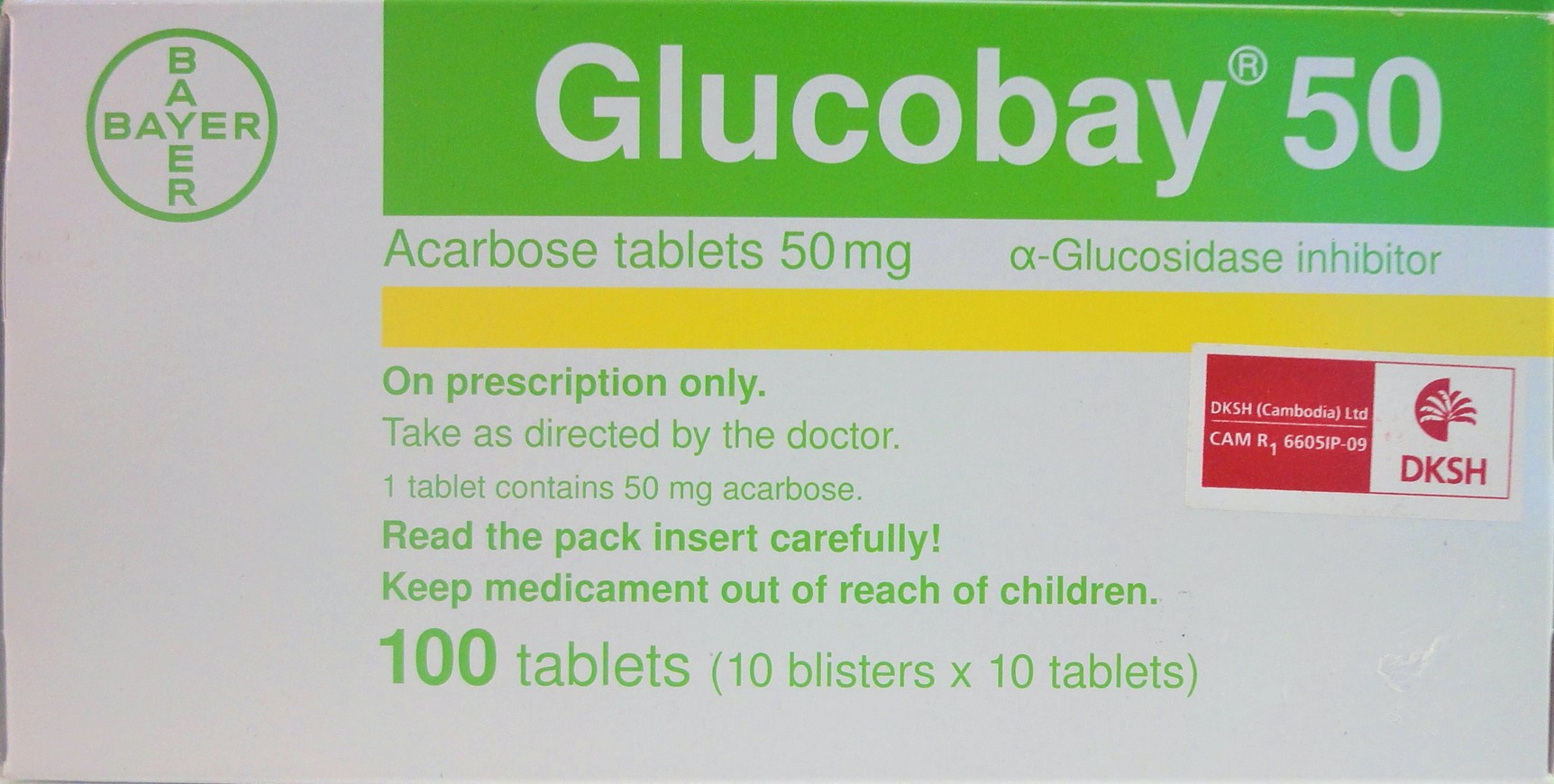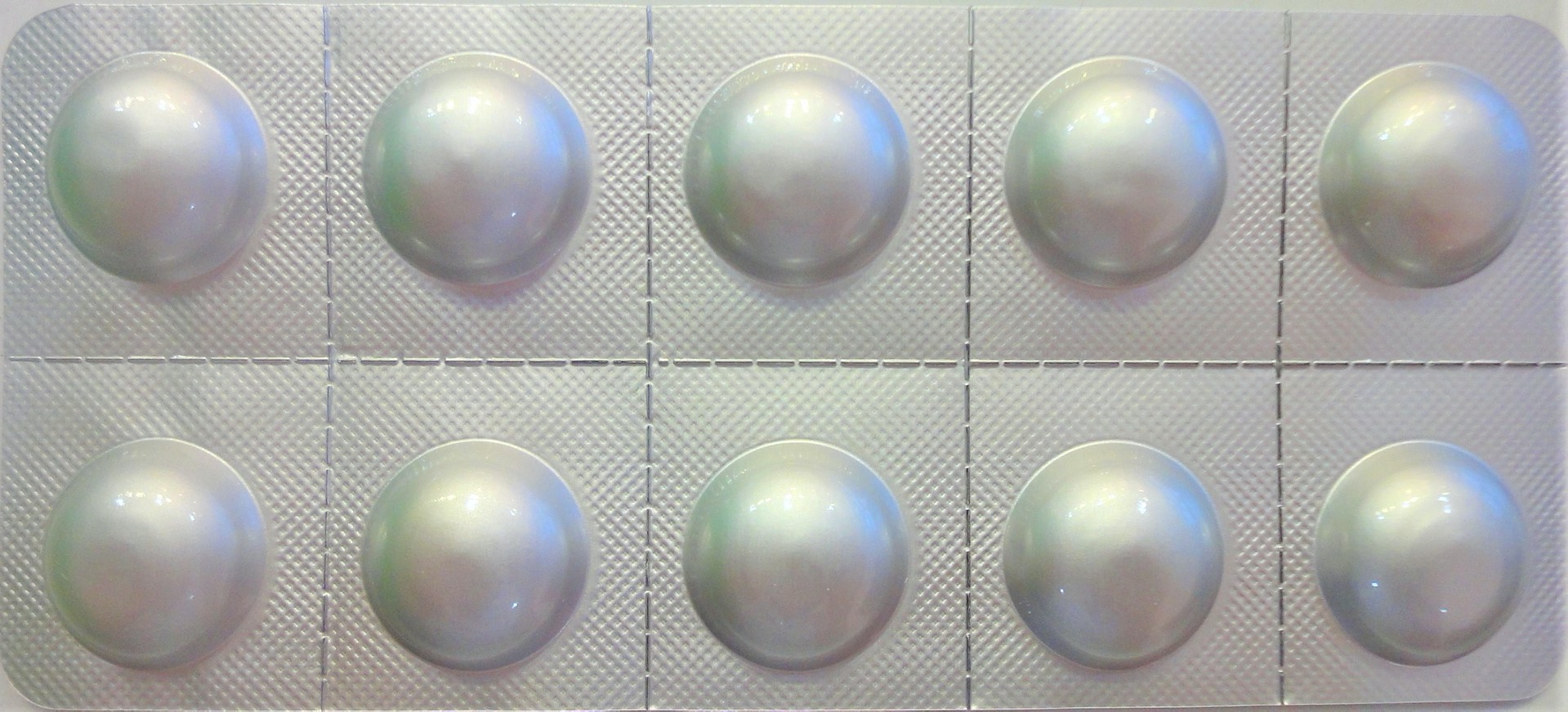GLUCOBAY Tablet
ក្រុមហ៊ុនផលិតឱសថ:
Bayer Pharma AG, Germany
ក្រុមហ៊ុនចែកចាយឱសថនៅប្រទេសកម្ពុជា:
DKSH


- សារធាតុសកម្ម
- ប្រសិទ្ធិភាពព្យាបាល និង កម្រិតប្រើប្រាស់
- ហាមប្រើ
- ផលរំខាន
- អន្តរប្រតិកម្ម
- ស្ត្រីមានផ្ទៃពោះ និង ស្ត្រីបំបៅដោះកូន
- ការប្រុងប្រយ័ត្នជាពិសេស
- សកម្មភាពឱសថ បរិយាយប័ណ្ណឱសថ
-
សារធាតុសកម្ម
-
ប្រសិទ្ធិភាពព្យាបាល និង កម្រិតប្រើប្រាស់
គុណភាពព្យាបាល
- ឱសថនេះមានសកម្មភាពលើពោះវៀន ដោយទប់ស្កាត់អង់ហ្ស៊ីម α-glucosidase ដែលអង់ហ្ស៊ីមនេះមានតួនាទីក្នុងការបំបែកពួក Carbohydrate អោយទៅជាគ្លុយកូស ងាយស្រួលជ្រាបចូលទៅក្នុងឈាម ដូច្នេះ នាំអោយថយចុះនូវការជ្រាបជាតិស្ករចូលក្នុងឈាម។
- ចំពោះអ្នកជម្ងឺទឹកនោមផ្អែម ត្រូវប្រើឱសថនេះរួមផ្សំជាមួយការតមអាហារ។
កំរិត និងរបៀបប្រើ
ប្រែប្រួលទៅតាមសភាពរបស់អ្នកជម្ងឺម្នាក់ៗដូចជា
- កំរិតប្រើដំបូង : លេបម្ដង 50 ម.ក្រ 3ដងក្នុង1ថ្ងៃ
- បន្ទាប់មក កំរិតប្រើអាចកើនឡើងដល់: លេបម្ដង 100 ម.ក្រ 3ដងក្នុង1ថ្ងៃ
- ករណីចាំបាច់កំរិតប្រើ: លេបម្ដង 200 ម.ក្រ 3ដងក្នុង1ថ្ងៃ។
(កំរិតប្រើអាចកើនឡើងក្រោយពេលប្រើបាន 4-8 អាទិត្យ បើសភាពជម្ងឺមិនបានធូរស្រាល)
- ក្នុងករណីមានសញ្ញាគ្រោះថ្នាក់កើតឡើងត្រូវបន្ថយកំរិតប្រើមកត្រឹម 300 ម.ក្រ។
- កូនក្មេង: ហាមប្រើក្មេងអាយុក្រោម 18 ឆ្នាំAdditional therapy in association with diet in patients with diabetes mellitus.
Dosage and method of administration
The dosage must be adjusted by the doctor to suit each patient, because efficacy and tolerability vary from one individual to another.
Unless otherwise prescribed, the recommended dosage is as follows:
Initially 3 x 1 tablet of 50mg Glucobay/day or 3 x 1/2 tablet of 100mg Glucobay/day
up to 3 x 2 tablets of 50mg Glucobay/day or 3 x 1 tablet of 100mg Glucobay/day
A further increase in dosage to 3 x 200mg Glucobay/day may occasionally be necessary.
The dose may be increased after 4-8 weeks, and if patients show an inadequate clinical response in the later course of the treatment. If distressing complaints develop in spite of strict adherence to the diet, the dose should not be increased further, and if necessary should be somewhat reduced. The average dose is 300mg Glucobay/day.
Method of administration:
Glucobay tablets are effective only if swallowed whole with a little liquid directly before the meal or be chewed with the first few mouthfuls of the meal.
-
ហាមប្រើ
ហាមប្រើ
- ចំពោះអ្នកងាយមានប្រតិកម្មជាមួយសមាសធាតុផ្សំណាមួយនៃឱសថនេះ
- ចំពោះអ្នកមានជម្ងឺពោះវៀនរ៉ាំរ៉ៃ ដែលធ្វើអោយមានការពិបាករំលាយអាហារនិងការជ្រាបអាហារជាមូលហេតុនៃការកើនឡើងនូវពួកហ្គាសក្នុងពោះវៀន
- ចំពោះអ្នកជម្ងឺខ្សោយតម្រងនោមខ្លាំង
- ចំពោះស្ត្រីមានផ្ទៃពោះ
- ចំពោះក្មេងអាយុក្រោម 18 ឆ្នាំ
- ចំពោះស្ត្រីបំបៅកូន ត្រូវពិគ្រោះជាមួយគ្រូពេទ្យមុនប្រើឱសថនេះ។- Hypersensitivity to Acarbose and/or to inactive constituents.
- Chronic intestinal disorders associated with distinct disturbances of digestion and absorption.
- States which may deteriorate as a result of increased gas formation in the intestine (e.g. Roemheld’s syndrome. major hernias, intestinal obstructions, and intestinal ulcers).
- Glucobay is contraindicated in patients with severe real impairment (CrCl<25ml/min).
-
ផលរំខាន

-
អន្តរប្រតិកម្ម
(see the package insert about details.)
Sucrose
Glucobay has an antihyperglycaemic effect, but does not itself induce hypoglycaemia.
Drugs containing sulphonylureas or metformin, or in addition to insulin
digoxin
Cholestyramine, intestinal adsorbents, digestive enzyme products
Oral neomycin
No interaction was observed with dimeticone/simeticone.
-
ស្ត្រីមានផ្ទៃពោះ និង ស្ត្រីបំបៅដោះកូន
ហាមប្រើចំពោះស្ត្រីមានផ្ទៃពោះ។ ចំពោះស្ត្រីបំបៅកូន ត្រូវពិគ្រោះជាមួយគ្រូពេទ្យមុនប្រើឱសថនេះ។
Pregnancy
Glucobay should not be administered during pregnancy, as no information from controlled clinical studies is available on its use in pregnant women.
Lactation
After administration of radiolabelled acarbose to lactating rats a small quantity of the radioactivity was found in the milk. There are as yet no corresponding findings in humans. However, as drug-induced effects of acarbose in milk have not been excluded in babies, in principle it is advisable not to prescribe Glucobay during the breast-feeding period.
-
ការប្រុងប្រយ័ត្នជាពិសេស
ការប្រុងប្រយ័ត្ន
ការប្រើឱសថអាចបណ្ដាលអោយ:
- ការកើនឡើងនូវពួកអង់ហ្ស៊ីមដែលបញ្ចេញដោយថ្លើម នៅពេលប្រើ Glucobay ដូច្នេះ អ្នកជម្ងឺត្រូវតាមដានកំរិតអង់ហ្ស៊ីមនៅអំឡុងពី 6-12ខែដំបូងនៃការប្រើឱសថនេះ ហើយអង់ហ្ស៊ីមចុះមកធម្មតាវិញ នៅពេលឈប់ប្រើឱសថនេះ។In clinical trials at doses of 50mg t.i.d. and 100mg t.i.d., the incidence of serum transaminase elevations with Glucobay was the same as placebo. In long-term studies (up to 12 months, and including Glucobay doses up to 300mg t.i.d.) conducted in the U.S., treatment-emergent elevations of serum transaminases (ALT and/or AST) occurred in 15% of Glucobay-treated patients as compared to 7% of placebo-treated patients. The elevations were asymptomatic, reversible, more common in females and in general, were not associated with other evidence of liver dysfunction.
Patient’s liver enzyme values should be monitored regularly, preferably at monthly intervals for the first 6-12 months after initiation of Glucobay therapy. If elevated transaminases are observed, a reduction in dosage or withdrawal of therapy may be warranted, particularly if the elevations persist. In such circumstances, patients should be monitored at weekly intervals until normal values are established.
Safety and efficacy of Glucobay in patients under 18 years of age have not been established. Glucobay should not be used in patients under 18 years of age.
-
សកម្មភាពឱសថ
Acarbose exerts its activity in the intestinal tract. In contrast to sulfonylureas, it has no stimulatory action on the pancreas.
The action of acarbose depends on an inhibition of intestinal enzymes (alpha-glucosidases) involved in the degradation of ingested disaccharides, oligosaccharides, and polysaccharides, but not monosaccharides. Maximal specific inhibitory activity is against sucrose. This leads. dose dependently, to delayed digestion of the above carbohydrates. The result is that absorbable monosaccharides (dextrose) originating from carbohydrates are released more slowly and hence more slowly taken up into blood. Absorption of monosaccharides is not affected. In this way, acarbose reduces the postprandial rise in blood glucose, the blood-glucose fluctuations in the course of the day become truncated, and the mean blood-glucose level is reduced. Acarbose lowers abnormally high levels of glycosylated haemoglobin.
*ព័ត៌មានឱសថត្រូវបានរៀបរៀងដោយ អ៊ីម៉ាតុគឹ មេឌីក (ខេមបូឌា) ដោយផ្អែកលើប្រភពព័ត៌មានខាងក្រោម។ សម្រាប់ព័ត៌មានលម្អិត សូមស្វែងរកនៅក្នុងក្រដាសព័ត៌មាននៃឱសថនីមួយៗ ឬ សាកសួរទៅកាន់ក្រុមហ៊ុនឱសថឬតំណាងចែកចាយនៃឱសថនីមួយៗ។
ប្រភពព័ត៌មាន៖
- ក្រដាសព័ត៌មាននៃឱសថសម្រាប់អ្នកជំនាញវេជ្ជសាស្ត្រដែលប្រើប្រាស់នៅប្រទេសជប៉ុន (Pharmaceutical and Medical Devices Agency, Pmda): https://www.pmda.go.jp
- ព័ត៌មានសង្ខេបនៃឱសថសម្រាប់អ្នកជំងឺដែលប្រើប្រាស់នៅប្រទេសជប៉ុន: http://www.rad-ar.or.jp
